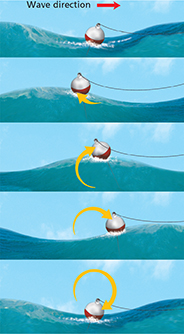Surface Waves
If you ask people to describe waves, most likely they will describe ocean waves before they think of the waves that travel in a rope or a spring. Ocean waves are the most familiar kind of surface waves. A surface wave is a wave that travels along a surface separating two media.
The ocean wave in Figure 4 travels at the surface between water and air. The floating fishing bobber helps to visualize the motion of the medium as the wave carries energy from left to right. When a crest passes the bobber, the bobber moves up. When a trough passes, the bobber moves down. This up-and-down motion, like the motion of a transverse wave, is perpendicular to the direction in which the wave travels. But the bobber also is pushed back and forth by the surface wave. This back-and-forth motion, like the motion of a longitudinal wave, is parallel to the direction in which the wave travels. When these two motions combine in deep water, the bobber moves in a circle.
Figure 4 As the ocean wave moves to the right, the bobber moves in a circle, returning to its original position.
Making Generalizations If these were breaking waves near the shore, what would happen to the bobber over time?

If you watched the bobber for ten minutes, it would not move closer to shore. Most waves do not transport matter from one place to another. But when ocean waves approach the shore, they behave differently. Perhaps you have seen seaweed washed ashore by breaking waves. As a wave enters shallow water, it topples over on itself because friction with the shore slows down the bottom of the wave. The top of the wave continues forward at its original speed. As a result, the wave carries the medium, along with any-thing floating in it, toward the shore.
Section 17.1 Assessment
Reviewing Concepts
 Describe how mechanical waves are produced.
Describe how mechanical waves are produced. List the three main types of mechanical waves.
List the three main types of mechanical waves.For each type of wave, compare the vibration of the medium to the direction of the wave.
Name one example of each type of wave.
Critical Thinking
Comparing and Contrasting How are transverse and longitudinal waves similar? How are they different?
Applying Concepts A spring hangs from the ceiling. Describe how a single coil moves as a longitudal wave passes through the spring.
Interpreting Diagrams In Figure 4, why is the first position of the bobber the same as the fifth position of the bobber?
Connecting Concepts
Energy Review potential and kinetic energy in Section 15.1. Then, describe the energy changes in a single coil of a spring as longitudinal waves pass through it.




